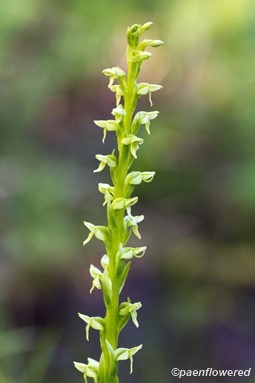Platanthera huronensis
Platanthera huronensis tall northern bog orchid
This rare native, perennial orchid is also known by the common name Lake Huron bog green orchid or tall northern green orchid. This species grows in wet meadows, marshes, seeps and bogs and along shorelines. This species is apparently descended from a cross between the north wind bog orchid (Platanthera aquilonis) and white northern bog orchid (Platanthera dilatata). The leaves are alternate and there is one leaf for each node along the stem. The normal flower color is pale green though some variations can produce white, yellow, or brown pigmentation. A hood is formed from one upper sepal and two lateral petals. The labellum (lower lip) is simple in form without a pouch; it is formed from the lower petal. The small flowers occur along a vertical spike. The flower usually has one nectar spur. Like most orchids, the flower is irregular in shape. The lateral sepals are spreading or slightly reflexed. The flowers emit a strong sweet scent.
Plants of this orchid may grow up to 3 feet tall and have wider leaves and may have a stouter stem than some related species. In Western Pennsylvania, it is only historically documented in Erie, Crawford and Warren Counties in the northwestern part of the state. Its range includes Canada and some of the more northern states of the United States, including southern Alaska. Except for some populations in the southern Rocky Mountains, Pennsylvania and New Jersey are at the southernmost end of its range. Many of the populations are scattered throughout its range. The flowering period is June to August, depending on location. It is similar in appearance to the northern green orchid (Platanthera hyperborean) that has darker green flowers. P. huronensis may hybridize with related species and more study is needed on its classification and general biology.
Habitat & Range
Very rare in wet meadows, bogs and woods.
Mostly found in the northeast and northwest of the state.
Range: Canada and some of the more northern states of the United States, including southern Alaska.
| EMP: | OBL |
|---|---|
| NCNE: | FACW |
Phenology
Flowers June through August.
Plant Codes
PA-satus: PE (Endangered)
S-rank: S1 (Critically imperiled)
G-rank: G5 (Secure)












Comments
Have you spotted this plant in your area? We'd love to hear about your experience! Share your comments or questions about the plant below. Comments are moderated before posting.